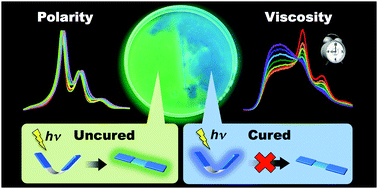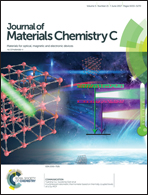Flapping viscosity probe that shows polarity-independent ratiometric fluorescence†
Abstract
A variety of fluorescent molecular viscosity probes have been widely used for mapping the local viscosity in cells and for monitoring the microenvironments in materials. However, their viscosity-sensing structural design still relies strongly on molecular rotors featuring intramolecular rotational dynamics. Here we report flapping molecules (FLAP) as a ratiometric viscosity-sensing fluorophore that shows polarity-independent dual fluorescence. Viscosity-sensing mechanism is based on a unique V-shaped-to-planar conformational change in the singlet excited state (S1), in which the flexible motion of an eight-membered ring plays an important role. Fast conformational dynamics have been studied by time-resolved spectroscopies, and the viscochromic properties have been quantitatively analyzed. Application of FLAP to monitoring the curing process of epoxy resins has also been demonstrated, in which other typical environment-sensitive dyes did not work as a local viscosity probe.



 Please wait while we load your content...
Please wait while we load your content...